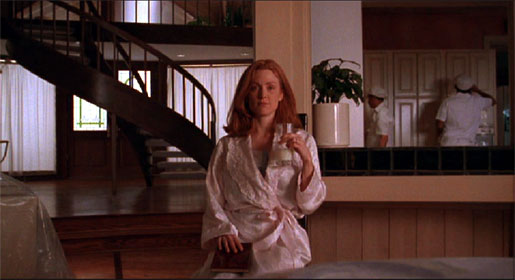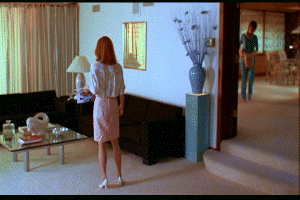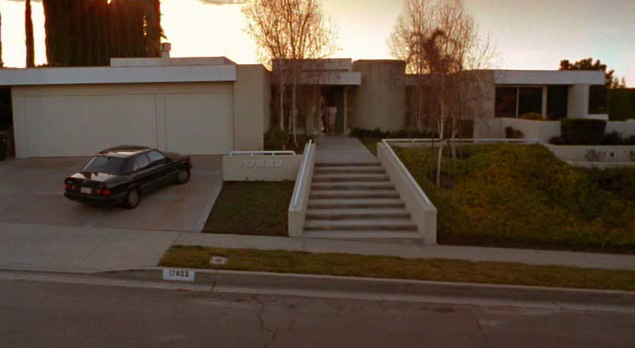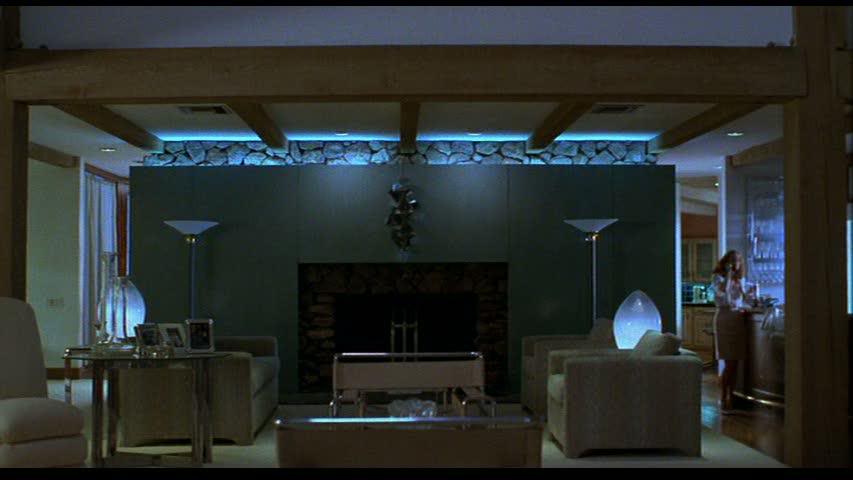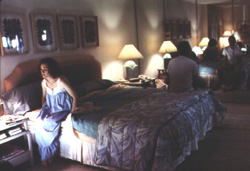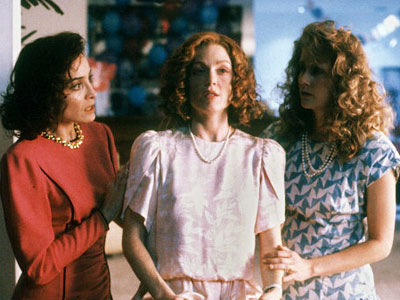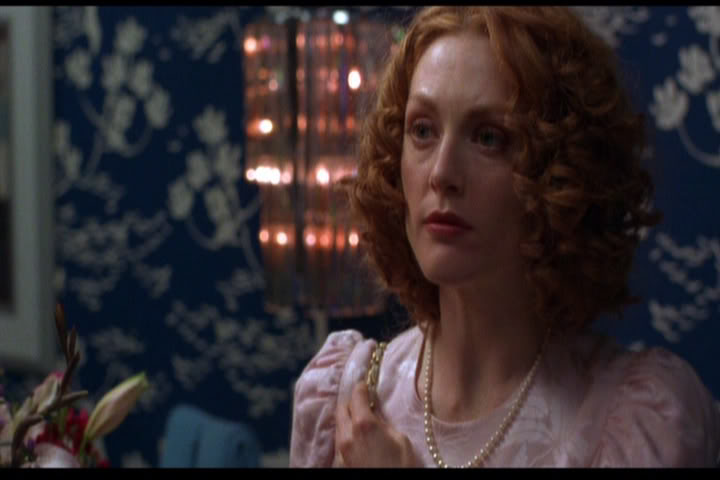From the Chicago Reader, July 28, 1995. —J.R.
Safe
Rating *** A must see
Directed and written by Todd Haynes
With Julianne Moore, Xander Berkeley, Ronnie Farer, Martha Velez-Johnson, Chauncy Leopardi, and James LeGros.
I know that Americans are supposed to hate whatever they can’t understand, and certainly current Hollywood filmmaking is predicated to the point of tedium on this truism. But part of what makes Todd Haynes’s Safe the most provocative American art film of the year so far — fascinating, troubling, scary, indelible — is that it can’t be entirely understood. The mystery and ambiguity missing from mainstream movies are all the more precious, magical, even sexy here, in a 35-millimeter feature employing professional actors set partly in the plusher suburban reaches of the San Fernando Valley.
By chance the star of Safe, Julianne Moore, also plays the female lead in the least mysterious Hollywood feature of the moment, the unspeakable Nine Months — a movie that essentially celebrates the world that Safe attacks. This makes Haynes’s film even more dangerous: seeing both films might be like combining chemicals that produce lethal explosives. One suspects that anyone who sees both in swift succession will be flirting with social or political revolution or some sort of madness. And given what the two films have to offer, revolution or madness may not be inappropriate responses.
My first encounter with Safe was two months ago, at Cannes; and though I had certain misgivings about it, the movie stayed with me in a way and to a degree that Haynes’s other films — Superstar: The Karen Carpenter Story, Poison, and Dottie Gets Spanked — have not. Yet I can’t claim that seeing the film a second time yielded substantially more treasures. What you see and hear is what you get. In fact the movie is distinctive in part because of its poetics of absence — the clearest sign of its indebtedness to Michelangelo Antonioni and Chantal Akerman.
Haynes’s layered constructions of sounds and images have a way of defamiliarizing — making strange, as the Russian formalists put it — the characters and settings. But having set this unhinging process in motion, Haynes seems as helpless as his spectators at controlling the fallout, and as a result there isn’t much agreement about the meanings expressed. Unlike some of my colleagues I would argue that this movie’s emotions are much clearer than its ideas, but certainly the degree to which satire figures in the film is not crystal clear. Attitude outstrips analysis in this movie by a ratio of about three to one, and one of the confusions fostered by this imbalance is the idea that Haynes’s hatred for his characters and their milieus and his precise grasp of their speech patterns (“All right, hands up, who wants decaf?”), their appearance, and their homes necessarily add up to a careful analysis of who they are and what makes them tick.
Such analysis is hardly essential to what Haynes is doing formally, but it becomes necessary once one considers how much this movie is saying as satire. As much as I may applaud Haynes’s skewering of the world of conspicuous consumption and privilege — the world for which this society is so bent on giving up things like art and education — I’m not entirely persuaded that he doesn’t belong to that world himself. Part of the movie, for instance, is devoted to smirking at 12-step programs, yet such programs do get some people off addictions. Haynes’s critique, like his depiction of the “designer” prison in Poison, offers a classbound view of class struggle.
Perhaps the biggest single area of confusion regarding Safe is the question of what the movie’s actually about. I would argue that Haynes’s hatred for most of what he’s showing is his real subject, and a perfectly legitimate one. But the movie’s press materials and most reviewers disagree: according to them, the movie’s subject is “environmental illness,” a buzzword that if I’m not mistaken first became widespread in 1987, the year in which the film is set. This “allergy to the 20th century,” whose victims develop extreme reactions to everyday chemicals, is richly suggestive of our unhappiness with the world we’ve created. But approaching it as a suggestive allegory isn’t at all the same as treating it seriously as a subject. Some critics have accused Haynes of making Safe a replica (ironic or otherwise) of a disease-of-the-week TV movie, but a much likelier source of inspiration is TV journalism — arguably even more dubious as a source of enlightenment. Such journalism has the power to further obfuscate the world we’re living in by giving names and illusory shapes to things that we know little about — that may not even exist.
I’m not in a position to say whether environmental illness exists or not, and neither is Haynes. But I can cite my own experience: in my early teens, when I was both socially alienated and afflicted with numerous allergies, I was given a scratch test and proved to be allergic to practically everything in it, even Alabama’s state flower. Later most of these allergies were reduced or eliminated by homeopathic injection. But the key issue, I would argue, is not whether environmental illness exists or whether that was what I had, but whether the formulation of such a concept is of any use to doctors and patients in the process of healing.
The role that environmental illness plays in Safe is above all dramatic; it organizes the plot. An obviously alienated wealthy housewife named Carol White (Moore) who always seems to be apologizing for her very existence develops physical symptoms related to her environment. Her doctor insists that nothing is wrong with her, but once the term “environmental illness” is introduced, the movie and the character gain narrative direction.
Moore’s portrayal of Carol, at times suggesting a squeaky mouse, is brutally effective but perhaps not entirely plausible. (“Nobody is that empty,” a filmmaker friend argued. But disagreements over plausibility in the film may be in part generational — after all, Haynes’s posthumanist, post-TV approach to his characters turned the Carpenter family into Barbie dolls in Superstar.) Carol’s first line is “It’s freezing in here,” said to her husband Greg (Xander Berkeley) in their garage as they get out of their car. Next we see them having sex in the missionary position, Carol going through the motions, clearly not enjoying it, as Greg grunts his way to a climax. Then we see her picking flowers in her garden, saying good-bye to Greg as he leaves for work, and informing some movers where a sofa should go in her living room. After her aerobics class, Carol hears another woman say that the 12-step program is just another form of addiction — a remark that anticipates the second half of the movie and seems to have Haynes’s full approval. Carol’s companions also note that she doesn’t sweat.
In the scenes that follow, everyday events seem to take the place of any plot, and all the interior and exterior spaces are made to seem massive, with Carol lost in their reaches like a loose cog. Even more impressive than Haynes’s visual sense is his sound track, which in these sections creates an eerie SF atmosphere and a feeling of displacement through a number of subtly alienating strategies. These immense, opulent suburban settings are inflected by our sense of their emptiness, not to mention Carol’s.
Carol returns home, leaves to visit a friend, comes home again after a visit to the cleaners, speaks to her mother on the phone, and is suddenly appalled to discover that a black rather than a teal sofa has been delivered. The next day, she wakes to find her house busy with painters and Latino servants already at work, returns to the cleaners, complains about the black sofa at Nelson’s customer service in Sherman Oaks, explaining that it doesn’t go with anything else she has. Then, while listening to an apocalyptic Christian fundamentalist on her car radio, she starts to cough from exhaust fumes, finally pulling into an empty parking garage, stopping her car, and doubling over as she wheezes.
From this point on, whether Carol’s watching a TV feature about “deep ecology” that looks and sounds like a commercial, falling asleep on the despised black sofa, or deciding with her friend to go on a fruit diet, the idea has been planted that illness is not so much an affliction for her as a much-needed validation, a form of identity. It’s a name for her nameless distress, which the film has been at pains to illustrate in numerous ways. Initially her “illness” takes the form of not responding to a dirty joke at a fancy restaurant with Greg and another couple; she apologizes to her husband on the way out, and he suggests she see her doctor. Predictably, the doctor tells her nothing is wrong and takes her off the fruit diet.
But after the movie has guided us through a few more episodes of the genteel nothingness comprising Carol’s creepy existence, more symptoms appear — a nosebleed at the beauty parlor, a recurring headache when Greg wants to have sex, and vomiting when she tries to make up with him the next day. These symptoms give us a certain relief as well as distress: for the first time, the movie has a recognizable plot, shape, and direction — Carol’s disease. Prior to that, there’s been nothing to respond to — just the so-called American dream of wealth, space, and comfort, and a concomitant sense of void, alienation, and boredom (which ads and commercials always make sure to leave out). Then along comes disease, and with it come focus, meaning, and purpose; and even if this meaning becomes a horror of a sort, at least it has a name, “environmental illness.”
Carol eventually goes to the Wrenwood Center, a New Age country retreat where the remainder of the movie is set. Here she’s assigned her own cabin, walks around with her own oxygen supply, and willingly submits to the center’s regimented lifestyle: sexually segregated meals, carefully directed group therapy sessions, and the ideology of self-love as a form of healing. Greg and her stepson come to visit her at one point toward the end of the film, but whether she’s on the road to recovery strikes me as a moot point. (Her “recovery” is about as meaningful as Vera Miles’s at the very end of Alfred Hitchcock’s The Wrong Man, a film of comparable negativity.) Carol has just moved into a bubble-shaped bunker on the center’s grounds that’s even more of a retreat from the world than her cabin; her only companions are her oxygen tank and her mirror. The fact that she loves herself, or thinks she does, may represent some marginal improvement in her condition, but considering the zero Haynes has chosen to make of her, it’s hard to know what her “self” consists of.
The Village Voice‘s Georgia Brown and the New York Free Press‘s Godfrey Cheshire, both intelligent critics, have accepted this ending as somehow hopeful rather than the final nail in Carol’s coffin (my own interpretation). Brown has even chastised me in print for calling Haynes “heartless” (in fact I called Superstar heartless), arguing that Safe is brimming over with compassion for Carol and Superstar with compassion for the Carpenter family, and I suppose Barbie dolls too. (After all, in more ways than one Safe is a remake of both Superstar and the disease-horror segment of Poison.)
Without wishing to put the man or his movies on trial, I beg to differ. Haynes may not dislike Carol as much as he does Greg or the fatuously cheerful founder of the Wrenwood Center (Peter Friedman), and he may sympathize with her acute alienation, but I don’t think he’s treating her as any sort of role model. In an interview with Alison Maclean in the summer issue of Bomb magazine, Haynes confirms this impression, noting that “basically, Safe is on the side of the disease and not the cure. It’s the disease that completely opens Carol’s eyes and the cure that returns her to [a] sealed-off existence.” He also remarks that Safe was partly inspired by his anger at a book by Louise Hay about AIDS published in the mid-80s, saying that it “literally states that if we loved ourselves more we wouldn’t get sick with this illness….That’s scary.”
Brown and Cheshire are both southerners by birth and haven’t lived in the Los Angeles area, so maybe Haynes’s southern Californian posthumanism — no doubt inflected by one’s distance from other people on the freeway and in Sherman Oaks living rooms — is relatively unfamiliar. But neither succumbs to the nearsighted view that Safe has something important to say about environmental illness — unlike the authors of a press release I received headlined “New Movie Misses Mark on Chemical Sensitivities.” It begins “Sony Pictures’ soon-to-be-released movie Safe pioneers thoughtful exposition of the devastating impact of multiple chemical sensitivity (MCS) on the estimated 2% to 10% of Americans who suffer from this painful, debilitating, and isolating illness. But, according to a nationwide support group of about 3,000 MCS patients, the film’s message is compromised by the vague ending which fails to address one of the most fundamental issues about this hideous disease [that its origin is physical, not psychological]. The public’s welfare is better served by knowing all the facts, say recognized health care professionals.” Apparently knowing anything about art — such as Haynes’s admission that his film is on the side of the disease, not the cure — is of lesser importance.

